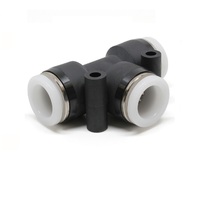
Item # PUSH IN FITTINGS EXPLAINED
BRIEF OVERVIEW OF PUSH-IN FITTINGS
- UM : EA
Push-In Fitting Basics
Pneumatic Applications often require flexible tubing, such as polyurethane, nylon, or polyethylene, to connect pressurized air supplies to actuators like cylinders, rotary actuators, and grippers. Originally, hose barbs and compression fittings were used. However, both of these styles have drawbacks. Hose barbs and compression fittings can damage tubing to the extent that installing a new fitting might require cutting away the old connection. Compression fittings are, in effect, single use, as the compression sleeve is deformed during installation. Not only are these fittings wasteful in an industrial setting, but the length of tubing runs is affected as used sections are cut away. To resolve this issue, pneumatic manufactures such as Pisco, Aventics, and Aignep developed the push-in or push to lock tube fitting.
Push-in fittings cover roughly 80% of most machine building applications. The most popular tubing types for use with push-in fittings are Polyurethane 95A, Nylon 78R, and Polyethylene 50D or 98A. The numbers after the material refer to the tubing’s durometer, or hardness. Durometer is very important, as push-in fittings require harder tubing construction than other fitting styles to maintain an airtight seal. The size of tubing used with push-in fittings is measured by the outside diameter (O.D.). It is classified either in inches and ranging from 1/8” to 5/8” or Metric ranging from 4mm to 16mm.
The Thread of the ports on pneumatic actuators and valves will typically be defined in the part number, item description, dimensioned drawing or in the catalog. These port sizes vary depending on what is required of the valve or actuator. Just like tubing, the port can be either inch or metric. Inch (Imperial) thread sizes are commonly 10-32UNF to 1/2”-14 NPT. Metric thread size can range from M3 to R1/2 or G1/2. It is important to note that thread sizes refer to inside diameter (I.D.) of the passage through which the compressed air flows, whereas tubing for use with push-in fittings is measured by O.D. Because of this, common fittings that combine threaded connections with push-in connections will have different sizes on each end of the fitting, i.e. 1/8” NPT by ¼” push-in. This maintains a more consistent passage for air flow, minimizing unwanted restriction and ensuring proper performance of the actuator.
Inch Thread Types:
- NPT= National Pipe Taper, which is a USA standard and meets ANSI/ ASME B1.20.1 standards. The ‘Taper’ described in NPT refers to the overall shape of the threads, being slightly cone shaped. This allows the external male thread to become firmly wedged into the internal female thread, helping create an airtight seal. Typically, thread sealant liquid, paste or tape is used to ensure a leak-free connection. An ‘M’ or ‘F’ after NPT describes a male or female fitting or port.
- UNF= Unified Fine, a standard for general machine screw and bolt threads used in the USA and Canada, also used on the smallest inch sized pneumatic ports and fittings. ‘10’ in 10-32 refers to a #10 screw diameter, while ‘32’ refers to the pitch, or number of threads per inch. UNF fittings and ports are not tapered and require a rubber or plastic face seal to make an airtight connection. 10-32 male fittings are compatible with M5x.8 female fittings, but M5x.8 male fittings are NOT compatible with 10-32 female fittings.
Metric Thread Types:
- BSPP or G= British Standard Pipe Parallel or G thread. A majority of European based companies use the G designation. These threads do not have the self-sealing properties of tapered pipe threads, instead relying on a separate rubber or plastic face seal or ‘O’ ring to provide an airtight connection. One issue with parallel pipe threads is that they will not work with ports that enter a curved surface, such as some cylinder caps or rotating actuator bodies.
- BSPT or RPT/RcPT= British Standard Pipe Taper or R(male) Pipe Taper/Rc(female) Pipe Taper. A majority of Asian based companies drop the ‘PT’ and use R or Rc. These threads use a tapered construction similar to NPT to help form a seal and are also usually used with liquid, paste, or tape sealant to make sure they are airtight.
- M-Sized= Metric fittings that use standard metric machine screw and bolt threads are used for the smallest metric pneumatic connections include M3 to M5 sizes, M5x.8 being the most common. The ‘M’ denotes a millimeter diameter, ‘5’ is 5 millimeters, followed by ‘.8’, the pitch, or distance between the threads in millimeters. As with the UNF fittings, M size fittings are not tapered and require a face seal to make a leak-free connection.
Universal Thread Types:
Although NPT, BSPP, BSPT, G and R threads all use fractional size designations (1/8, 1/4, 1/2, etc..) they are NOT compatible across thread types. There are, however, Universal male threads found on some push-in fittings, that use a face seal similar to a male G thread fittings combined with a short and tapered thread section. The pitch and taper of Universal male fittings is such that a few complete turns can be made in either inch or metric female threads of the corresponding size before the threads jam or the short thread section bottoms out in the fitting. These few turns draw the fitting body against the seal, allowing one fitting to adequately connect with inch or metric ports. As with male G thread fittings, Universal male thread fittings can only seal when used on ports entering flat surfaces.
NOT FINDING WHAT YOU NEED?
SEND US AN E-MAIL:
SALES@THEPNEUMATICSTORE.COM
Specifications
| ARTICLES REGUARDING | AUTOMATION COMPONENTS |

